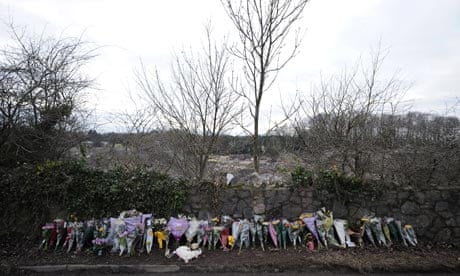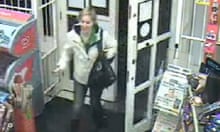The case began as a missing-person inquiry, made more poignant and newsworthy because the young woman had disappeared during the festive period.
But after Joanna Yeates's frozen body was discovered on a snowy roadside verge on Christmas morning, it became a huge murder hunt and a story that gripped the UK and international media.
The solution to the mystery turned out to be simple: the 25-year-old landscape architect was killed by her neighbour, the Dutch-born engineer Vincent Tabak.
To the torment of her loved ones, however, the truth about exactly what happened on the night of 17 December last year in Flat one, 44 Canynge Road, Bristol, may never be known.
Tabak waited until the last possible moment – when he was in the witness box – to offer his version of events.
He claims Yeates invited him into her flat and made a flirty remark as they chatted in the kitchen, which encouraged him to make a pass at her.Tabak says she screamed, and to stop her he gripped her throat with his right hand and put his left over her mouth. After about 20 seconds she slumped lifelessly to the floor.
The police and prosecution believe there are huge holes in Tabak's account. They think this was a sex attack and that Tabak might have derived a thrill from the act of strangling his neighbour, from having her at his mercy and under his control.
They have suggested Tabak might have been spying on Yeates and may have found an excuse to knock on her door that night rather than being spontaneously invited in.
The attack may have started in the hallway, which was found in a chaotic state. It could have continued in the bedroom: one of the earrings Yeates is thought to have been wearing was discovered beneath the duvet. There is also the possibility that something may have happened after Tabak carried Yeates's body back to his own flat. Certainly, according to the prosecution, there was a delay of more than an hour before he put her body into the boot of his car and drove it away.
Finally, what police and pathologists discovered when they examined Yeates's body suggested more went on than Tabak admits to recalling.
She had suffered 43 injuries, including wounds to her face, throat and arms. Though her jeans had not been tampered with, her T-shirt had been pulled up above her breasts and part of her right breast exposed. A sample of Tabak's DNA was found on her chest, however scientists could not establish what it came from.
The bottom line is that nobody apart from Tabak can say what happened – and he claims his memory of exactly what happened remains sketchy.
Not at all sketchy are the last known moments of Yeates's life. They have become all too familiar. She vanished eight days before Christmas after leaving the Ram pub on Park Street in Bristol, where she had been enjoying after-work drinks with work colleagues. It was cold and snow and ice lay thick on the pavements.
Yeates bought a tomato, mozzarella and basil pizza from a supermarket and picked up two bottles of cider from an off-licence. Police believe she got back to her Clifton flat, which was already decorated in readiness for Christmas, at about 8.45pm.
Within moments – at about 8.50pm – partygoers heading to a nearby house heard two screams. And then silence.
Yeates's boyfriend, Greg Reardon, returned from a weekend away on the evening of Sunday 19 December to find Yeates missing, though her mobile phone, keys, purse and coat were there.
At 12.45am he dialled 999 and less than four hours later a police officer banged on the door of Flat two. Tabak answered and denied all knowledge.
His denial led to – in Tabak's own words – a "week of hell" for Yeates's family and friends. Over the next seven days police and family issued a series of increasingly desperate appeals for help in finding her.
On 23 December police revisited Tabak and carried out a routine search of the flat he shared with his girlfriend, Tanja Morson, to check Yeates was not there. He joked to friends that they must have thought he had stashed her in a drawer.
Tabak and Morson, the daughter of a Harvard-educated lawyer, then left Bristol to spend Christmas in Cambridge at her parents' home.
On Christmas Eve, Detective Constable Karen Thomas, a member of the police's major crime investigation team, spoke to Tabak by telephone about his movements on the night of Yeates's disappearance. He told her he was in all evening before driving in the early hours of the morning to pick up Morson after a work party.
He was able to say he did not know Yeates. She and Reardon moved in at the start of October 2010 and he left for a business trip in California on 6 November, only returning on 11 December, six days before the killing. They were in effect strangers.
On Christmas morning, at about the time Tabak and Morson – who remained ignorant of her boyfriend's crime – were opening their gifts, Yeates's body was found by a dog walker, covered in leaves and a pile of snow next to a quarry wall at Longwood Lane, Failand, three miles from Clifton. It looked as if the killer had tried to heave the body over the wall. Had he succeeded Yeates could still be a missing person.
The media interest became a frenzy. One tabloid suggested Yeates may have been held captive for several days before she was killed. Another theory was that she may have been dumped at the scene alive and died of hypothermia. The public was fascinated by the details. What had happened to the pizza, which was never found? Why had she bought two bottles of cider? Was she meeting someone? Was the killer waiting for her at the flat? Why was there no sign of a break-in?
Only Tabak knew the truth and he was not telling. On 28 December he and Morson drove via Eurotunnel to the Netherlands where they were to spend new year with Tabak's family.
There was no escape from the Yeates story in the Netherlands. On 30 December, Tabak and Morson watched a television news report of the arrest of Joanna Yeates's landlord, the former public school teacher Christopher Jefferies, over the killing.
At this point Tabak made a huge mistake. Spotting a chance to frame Jefferies, he contacted Avon and Somerset police and suggested the landlord had been out and about in his car on the night of Yeates's death. The murder team sent DC Karen Thomas to Amsterdam and on New Year's Eve she spoke to Tabak at a hotel near Schiphol airport for six hours.
For the first time, Tabak's behaviour seemed suspicious. He talked to her about Jefferies but seemed, in Thomas's words, "overly interested" in the forensic examinations police were carrying out. Tabak also gave Thomas a different version of what he had done on the night of Yeates's disappearance, explaining that he had gone out twice, once to take photographs of the snow and the second time to go to Asda.
He also suggested he may have once set foot in the hallway of Yeates's flat, not when she was there but when he was chatting to Christopher Jefferies before Yeates disappeared. Thomas asked him to provide a DNA sample and fingerprints so they could be eliminated if they were found in the flat. Tabak appeared concerned but cooperated.
Jefferies was released on police bail on New Year's day and Avon and Somerset police found themselves on the back foot, having to deny they were back to square one.
Tabak, of course, assumed the net was closing in. When he and Morson drove back to the UK on 2 January, Tabak expected to be arrested as soon as he cleared customs. Every day he waited for the police to knock on his door. He began to drink and take sleeping pills. He thought about jumping off Clifton suspension bridge.
The knock finally came on 20 January – three weeks after he spoke to police in Amsterdam. He was told that his DNA had linked him to Yeates's body.
He tried to blame the laboratory that had carried out the testing, suggesting it was insecure, even that a scientist may have been paid to set him up.
But the DNA evidence was damning and 30 days after killing Joanna Yeates, Vincent Tabak appeared before Bristol magistrates charged with her murder. In May at the Old Bailey he admitted manslaughter but denied murder.
In court he told his extraordinary story during two days in the witness box. How, after Yeates's death, he had bundled her body into his car boot before going shopping to Asda for beer and crisps and texting his girlfriend that he was "bored". He accepted that, following the killing, he had researched subjects such as the difference between murder and manslaughter and the definition of sexual assault. But he repeatedly said he could not remember how Yeates had come by her 43 injuries – beamed on screens around the court – or even whether she had been frightened.
Privately, detectives believe Tabak can recall what happened in Yeates's flat perfectly. They think he calculated that there was no point in denying that he had killed her but gambled that the detectives would not be able to prove he meant to do so.
Avon and Somerset police may now have some questions to answer. Why did they not look into Yeates's next-door neighbour more closely until he contacted them with supposed information about Christopher Jefferies? Did they preserve the scene of the crime properly in the early days? Why did it still take three weeks for them to arrest Tabak after he gave his DNA sample?
The police deny they were slow in getting to Tabak, saying he left the Bristol area before Yeates' body was found. Officers also revealed that it was "early January" when they had an "interesting development" regarding Tabak's DNA sample and possible links to Yeates' body. Confirmation took more time.
Of course, in the end, the death of Joanna Yeates and the continuing agony her family must suffer partly because so much remains unclear is down to Vincent Tabak.
"He is a clever young man who thinks he can play a clever game," said one senior police source. If he is playing a game, it is a cruel one for those who were closest to Joanna Yeates.





